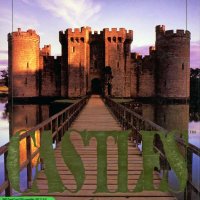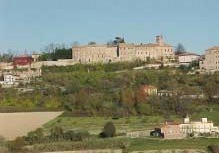Castles

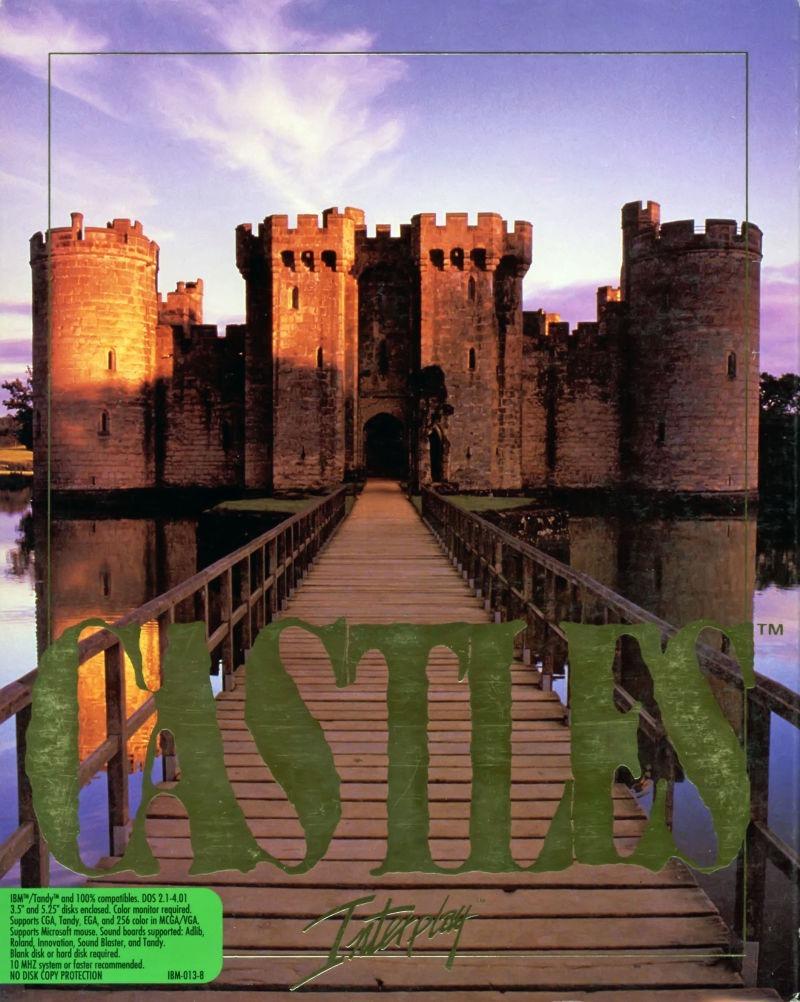
"Is there anyone who isn't fascinated by castles?" reads the copy on the back of the manual for Interplay's new game, CASTLES. Indeed the massive fortresses of the Middle Ages, with their associations to legend and history, do seem like an irresistible subject for a game. Interplay's CASTLES aims to integrate features of war games, role-playing games, and simulations such as RAILROAD TYCOON into one package. Unfortunately, CASTLES falls far short of what it should have been. Instead of being as addictive as SIM CITY, CASTLES quickly becomes tedious. Real life castles are fascinating, but Interplay's CASTLES isn't. (This review is based on the MS-DOS version.)
The goal in CASTLES is to design and build a castle while defending it from enemy attacks. The player designs a castle by selecting a piece and then laying it on the overhead design map. There are two basic castle pieces: walls and towers. Walls can be one of three different heights and three different widths, and may have arrow slits or cauldrons of boiling oil built into them. These extras are costly, as the taller and thicker a wall is the longer it takes to build. Towers may be either round or square, and can be one of three different heights. Round towers provide better protection, but take longer to build. There is a third castle piece, the gate, which is required to complete your castle. Gates can be opened and shut, which is sometimes useful for releasing infantry during a battle.
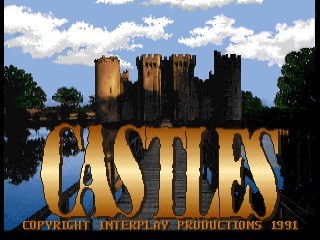
After laying out the castle, the player must assign workers to build it. You can hire many different sorts of specialized workers, such as diggers, quarrymen, and carters. You can also change the wages you pay them (of course, if you don't pay them much, you may find no one is willing to work for you). Construction is illustrated on the screen by small animated figures bustling back and forth digging, sawing, and working on scaffolds. They even wave to you when they finish a wall segment. The castles are nicely rendered in perspective, and can be viewed from two angles.
Workers have to be paid, of course, and to pay them you have to collect taxes. The player gets a certain amount of tax revenues each year, the amount of which increases with the number of castle pieces he has. The player can also collect monthly levies, although this method of finance tends to upset the peasants. The player has to be sure to keep enough money on hand to pay both his workers and his military -- if the player runs out of money his employees abandon him.
Construction is interrupted by two kinds of events: messengers and battles. Messengers arrive every game month and present the player with political and military problems. The player must then choose among three possible solutions. For example, the messenger may say that an outlaw has been captured and give the player the options of imprisoning him, beheading him, or setting him free. These incidents are strung together to form miniature stories, so that the outlaw you fail to behead today may return to bedevil you tomorrow. The messenger events vary randomly from game to game, giving the game replay value.
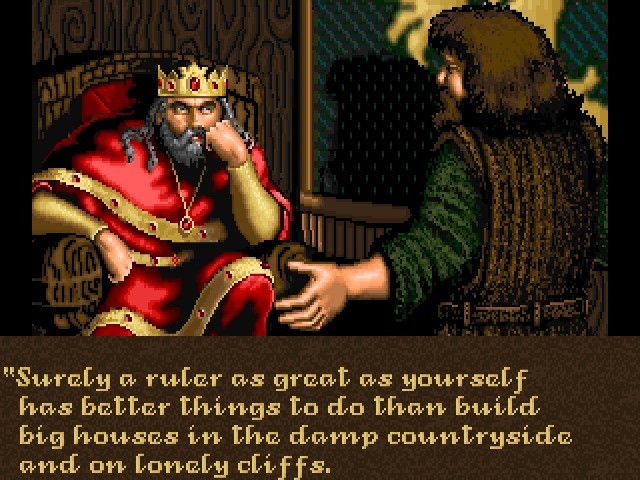
Battles can occur both randomly and after you make major decisions. In battle mode you place your archers and infantry on the map (not necessarily within the castle itself) and then watch the battle take place. Each infantry unit can in principle be controlled by clicking on the unit and then clicking on its destination. Archers cannot move during a battle, though you can control which target they fire at. Battles end when you wipe out the opposing sides forces or when they tear down most of your castle, whichever comes first. Losing a single battle also means losing the game, so players are advised to save often.
Players can choose single castle, three castle, or eight castle campaigns set in either a realistic or a fantasy setting. The campaign is complete when the player has completed the required number of castles in succession. There are eight areas total that must be pacified, ranging from grassland to swamp. Landscape terrain varies from area to area, but not from game to game. There are three different difficulty levels plus a practice mode. Increasing the difficulty level reduces tax revenue and increases the probability and severity of enemy attacks. The difference between the fantasy and realistic modes is small, affecting mainly the messenger vignettes.
If all the features described above had been properly implemented, CASTLES would be a very good game. As it is, the best that can be said about CASTLES is that it is mildly entertaining for a few hours. Seeing your castle design constructed before your eyes gives the player the same simple satisfaction that playing with blocks does, and watching the animated workmen and soldiers wander around is fun, too. But once the initial thrill is gone, CASTLES fundamental flaws emerge: a poorly written manual, lack of depth and variety, and historical inaccuracy.
Gameplay in CASTLES covers a wide variety of subjects, ranging from proper castle construction to managing revenues to military strategy. One might expect a nice fat manual bursting with information, just like the SIM CITY and RAILROAD TYCOON manuals. Unfortunately the CASTLES manual is thin and sloppy. Often vital information is missing, such as the definition of resource points, an explanation of when moats may or may not be dug, and the requirements for a completed castle. The section of the manual devoted to a tutorial is presented as a hard-to-read, tongue-in-cheek dialogue between a knight and his squire that jumbles together important information, bad jokes, and faux-medieval dialect. Space that could have been used to explain the game is instead given over to a list of "Five Good Reasons Not To Be a Peasant in the Middle Ages" and a lengthy, irrelevant, and not very accurate account of the deeds of the early Plantagenet kings. Basic information on castle design is scattered throughout several sections, or not given at all.
The poor manual compounds another problem of the game, namely its monotony. After building your first castle, you have seen just about all the game has to offer. Essentially all you do is lay out your castle, assign your workers, and deal with the infrequent messengers and battles. This leaves long, long stretches where there is nothing to do but watch your workers work. One can tinker with the taxes or the food supply (used in sieges), but this is seldom necessary. You can adjust the number of workers on each segment of the castle, but this is easily and quickly done. One can try to improve the composition of your workforce, but the game gives you little feedback on how to do this. All one is told is if one's overall workforce efficiency is "Poor," "Satisfactory," "Good," etc. These generalities are of little help in determining whether you should hire more carpenters or increase the pay of your masons, and the manual isn't much help either. You can try and improve your efficiency rating by trial and error, but it's far less aggravating to just stick with the "Satisfactory" default settings.
What CASTLES lacks are the graphs, charts, and reports that are found in such abundance in SIM CITY and RAILROAD TYCOON. All CASTLES provides in this area are the most basic statistics about the number of employees, their wages, and overall income and expenses. It would be wonderful to see graphs showing the efficiency of masons over time, say, or the growth of revenues, or the size of the food supply. Then the player would be able to spend the dead time between messengers and battles consulting the reports and fine tuning his allocation of resources. Most of the player's time in RAILROAD TYCOON and SIM CITY is spent in just such fine-tuning, and it's what makes those games so addictive.
Although the messengers and battles are entertaining compared to the construction phase, these segments also have their drawbacks. While some messenger vignettes are entertaining (such as the story of the outlaw mentioned above), others are dull or pointless. Often picking the right solution is just a matter of reading the manual. When the manual states that the Duke of Norshire is incompetent and cowardly, or that the Abbess of St. Martha's is crazy, it's pretty obvious how these people should be treated. In a way, the messenger segments add to the monotony since only one messenger arrives a month: no more, no less. If you send an army off to battle in a faraway land in April, you can be sure it will be May before you learn the result; if you exile your brother-in-law in October, you can be sure you won't hear about the political fallout till November.
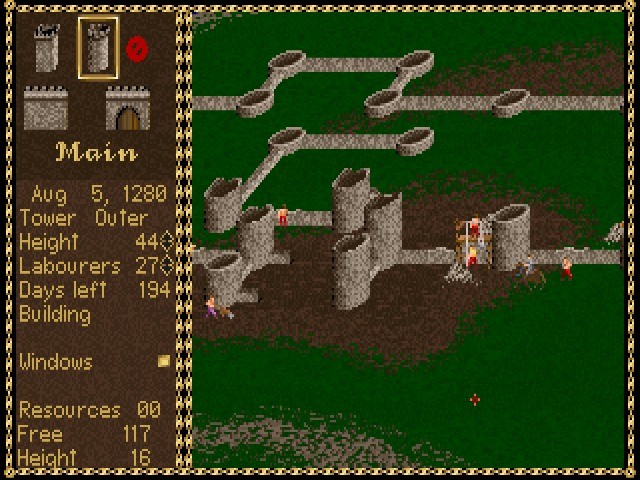
Battle quickly becomes dull as well. The computer's artificial intelligence routines are poor. Enemy forces appear on the map, walk straight towards the castle, and attack your troops and castle walls. The computer enemy does not exploit weaknesses in your castle design, and tends to attack from the same direction. Thus if the enemy usually attacks from the east, you can dedicate your time to building up the east wall and neglect the others. The enemy will walk right into the trap instead of attempting to circle around to attack from another direction. Terrain seems to make little difference in battle -- armies walk at the same speed over water as they do over grass. This means there is little point in positioning your castle to take advantage of the terrain. Although you are supposed to be able to click on infantry units to give them orders, in my experience the clicks seldom "take" and your infantry simply walks in a straight line towards the enemy. Alas, this means they often get stranded behind wall segments where they are of no use to anyone. (This problem may simply be a quirk with my system, but as I use a Microsoft mouse on an IBM system, I doubt it.) Battles are therefore a routine matter of putting your troops in place and watching the two computer-controlled armies slug it out.
The monotony of the game might be excusable if it was an accurate simulation of medieval castle building. Yet the castles in CASTLES bear only the slightest resemblance to their historical counterparts. For example: All walls in CASTLES are stone. Stone walls are expensive, and can only be built slowly. In CASTLES this means there are often large gaps in the castle walls because the player can't afford to build the entire wall at once. In history the real castle builders avoided such problems by doing the obvious thing -- they used wood when they could not afford stone. Wood walls were cheap and quickly built. Many medieval castles had stone keeps and wood surrounding walls, with the wood walls being gradually replaced with stone ones when the owner's pocketbook allowed. In fact, many early castles were made entirely of wood and bore a greater resemblance to the palisaded forts of the Wild West than the massive stone structures of the later Middle Ages. CASTLES forces the player to do something a medieval strategist would consider suicidal, namely leave large gaps in the defense, simply because it requires the player to use stone walls.
Another example: In CASTLES, sieges are very simple. At the start of a battle the enemy decides whether to lay siege to your castle. If they do, your food supply begins to drop. When it hits zero, your troops begin to die at a very rapid rate. Eventually the enemy stops the siege (though why they do so is unclear, since they are quickly killing off your armies by starvation) and a regular battle begins.
This has little to do with real medieval sieges. A medieval siege was always a two-sided affair. Those within the castle had limited food supplies, but usually so did the besieging army. The defenders had to rely on their stores, but the attackers had to rely what they could plunder from the nearby area. The attackers also had to worry about being cut off from their supply lines by the defender's allies; about maintaining discipline during a lengthy siege; about the disease that always struck army camps; about the onset of winter and the end of the campaigning season. The game was seeing which side would give in first. Yet in CASTLES the enemy's food supplies are never depleted; the enemy's troops suffer no attrition due to disease or desertion; the enemy is never forced to withdraw because of winter or the approach of the defender's allies. The siege in CASTLES is simply a way of whittling away your forces to give the computer opponent an edge.
These objections might be dismissed as historical nitpicking. Just because CASTLES doesn't depict history perfectly doesn't necessarily mean it's a bad game. After all, RAILROAD TYCOON took some major liberties with its historical subject matter and yet RAILROAD TYCOON is a classic game. But CASTLES fundamentally misrepresents what castles were and how they worked. Instead of being the sophisticated and efficient tools for holding a territory that they were in history, CASTLES portrays castles as fragile and ineffective.
This is due to a major flaw in the combat system. In reality breaching a castle wall was a long, difficult business involving tunneling under a wall and undermining it. In CASTLES, enemy infantry simply walk up to a wall and push it over with a minimum of effort. The cauldrons of boiling oil in a wall can kill an attacker, but for some reason each wall is only allowed one dose of oil per battle. Archers are of little use. They do very little damage to begin with, and since they not allowed to shoot at tight angles they are ineffective when the enemy gets too close. This means once a enemy unit reaches a wall it is very difficult to stop him from pushing it over.
The key to victory is therefore killing off the enemy before he reaches the walls, and since archers are so ineffective the only way to do that is to place your infantry _outside_ the castle. That way they can intercept the enemy before he gets too close. Of course, the infantry takes terrible casualties with this strategy. The infantry labor pool is apparently refilled each game year, however, so this is no great loss. Simply hire a new crop of cannon fodder (sword fodder?) next year. But this is the exact opposite of the way real castles worked. Real castles existed so that the castle walls would absorb the attacks meant for people. In CASTLES, where completing the castle is the sole route to victory, the smart thing to do is to let people absorb the attacks meant for the valuable castle walls. Real castles existed to protect important assets -- people and their property. In CASTLES the castle walls are an end in themselves.
Paradoxically, this means that there is no reason to build a castle in CASTLES. The following strategy works better than building one central structure: Place the keep and the gate (both of which are required for a completed castle) in the middle of the map. Then instead of building walls around the keep, build a large network of free standing towers. When the enemy attacks, it will march single mindedly towards the central keep. It will ignore most of the towers alone unless they are directly in its path. By placing your archers in the correct towers you can create a long corridor of crossfire for the enemy to walk through en route to the keep. If you plan it carefully the enemy will never get within bowshot of the central keep and damage to the "castle" -- the network of towers -- will be minimal.
On the plus side, CASTLES has nice VGA graphics and a smooth, mouse-driven interface. It is relatively bug-free (but don't save games during battles). The game engine is easy to use and a good starting point for a castle simulator; one hopes that Interplay will someday roll up its sleeves, do some comprehensive rethinking of the project, and produce a CASTLES II that accurately reflects its namesake.
CASTLES supports CGA, Tandy, EGA, MCGA, and VGA graphics, and comes on four 5.25" and two 3.5" diskettes (boxed together). The game requires 540K to run in VGA mode; 555K to run in VGA mode with music. A color monitor is required. The game's only copy protection is a simple manual lookup during the installation routine. It supports all the major sound boards (though as with all strategy games you will probably quickly turn off the music). A 10 MHz or better machine is recommended (on my 12 MHz machine, only the fastest speed was tolerable).









